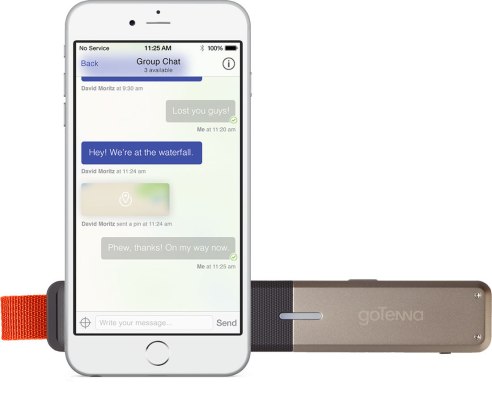GoTenna co-founder Daniela Perdomo knows that her startup has been “quiet for a long time,” but she said it’s for a good reason — the team has been busy turning its prototype into something that could be “manufactured at scale.”
The company aims to help users to communicate even when they don’t have any cell signal, whether it’s because they’re in the wilderness or at a crowded festival. The company launched a preorder campaign midway through 2014, and now the product’s officially available for purchase.
Early users have tested goTenna for things like hiking, snowports and silent outdoor activities like hunting and fishing. Perdomo gave me a somewhat less adventurous demo when I visited goTenna’s Brooklyn offices — after downloading an app (something you probably want to do before heading into the wilderness) and pairing with iOS and Android devices, she could send text messages, even without a cell or WiFi connection.
Those messages can be sent one-on-one, within groups or even broadcast to everyone nearby. (Don’t worry, you can also block people.) Users can send their GPS location as well, viewable on a pre-downloaded map — useful whether you’re facing some emergency and need help, or if you’re just trying to meet up with a friend.
Given the prevalence of outdoors-y use cases, Perdomo acknowledged that some people might wonder, “Isn’t the point of being off-the-grid to be off-the-grid?” In other words, if you’re going skiing or rock climbing or whatever, do you really want you friends to be able to text you?
“It’s not about Instagramming the world,” Perdomo said. “It’s about saying, ‘Come meet me at this sunset. This is where I am.'”
Backing up that argument: goTenna won’t let you share anything other than text and location, at least not yet.
The devices are light, weighing only 1.8 ounces, and designed to be clipped to a backpack or other gear. Perdomo added that the range will vary depending on the terrain — in New York City, it’s usually limited to a few blocks or half a mile, while outdoor groups have reported communicating across distances of up to four or five miles.
As for power, the device should be able to send 700 messages, and receive many more than that, on a single charge.
goTenna devices cost $199 per pair. You can’t buy them individually, but hey, there’s not much point in texting alone. (There’s currently a $25 Black Friday/Cyber Monday discount, which includes limited edition black-on-black devices.) Perdomo noted that this breaks down to about $100 per unit, significantly less than a fancy satellite radio.
Even better, there’s no subscription fee. Perdomo said the company might eventually charge for additional services, but the core messaging capabilities will always be free. After all, she and her brother Jorge came up with the idea partly as a way to communicate during a disaster like Hurricane Sandy, so it’d be pretty bad if people were cut off during an emergency because they hadn’t kept up with their payments.
In a similar vein, goTenna is actually partnering with the New York City Economic Development Corporation to provide devices to small businesses so they can communicate during a disaster.
